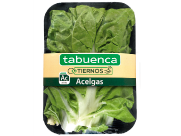CHARD |
|
Aristotle mentioned chard in the 4th century B.C. It is considered a basic food for human nutrition, a bi-annual plant with a long life cycle which does not form roots or edible fruit. The leaves are large and oval, growing in heart shapes, being the edible part. Its colour varies, depending on variety, between dark green and light green. The best known are: Lyon Yellow, Bressane green with white stalks, Niza, Paros, Grenn and Fordook Giant. Chard has numerous medicinal and dietary applications, being emollient, refreshing, digestive, diuretic and nutritious. With lemon juice, chard strengthens the stomach and invigorates the brain, also reducing kidney, urethra and renal pelvis inflammation, as well as helping with liver problems, hepatic colic and renal colic, gout, rheumatism, diabetes and skin diseases. |
Related Products
 |
| Tender Chard |
CHARD
Aristotle mentioned chard in the 4th century B.C. It is considered a basic food for human nutrition, a bi-annual plant with a long life cycle which does not form roots or edible fruit.
The leaves are large and oval, growing in heart shapes, being the edible part. Its colour varies, depending on variety, between dark green and light green. The best known are: Lyon Yellow, Bressane green with white stalks, Niza, Paros, Grenn and Fordook Giant.
Chard has numerous medicinal and dietary applications, being emollient, refreshing, digestive, diuretic and nutritious.
With lemon juice, chard strengthens the stomach and invigorates the brain, also reducing kidney, urethra and renal pelvis inflammation, as well as helping with liver problems, hepatic colic and renal colic, gout, rheumatism, diabetes and skin diseases.
Related Products










